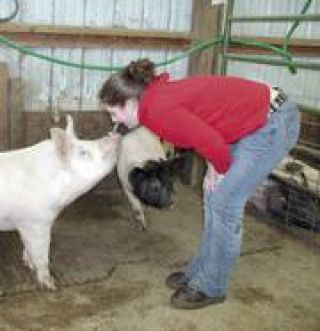Kids preparing for Livestock Show
By Brenda Sexton
The Courier-Herald
The months fly by when you are raising a hog for market, say White River High School students who borrowed money from the USDA's Farm Service Agency in December to purchase their 10-week old Yorkshire and Hampshire crossbreed hogs.
Now it's April and time to sell those hogs to repay the loan and hopefully post a profit, too. White River's FFA students, along with Enumclaw FFA and 4-H clubs, will participate in the Northwest Junior Livestock Show and Sale April 10-13 at the Western Washington Fairgrounds in Puyallup.
This is the first year White River has participated in the FSA's Rural Youth Program. Each student borrowed between $190 and $210 to raise a weaner pig to maturity. According to White River FFA adviser Todd Miller the program is a godsend for many students who otherwise wouldn't have the cash it takes to start an animal agriculture project.
Miller said the loan opportunity nearly doubled his chapter's participation. Last year, White River students raised 14 hogs. This year they raised 24.
"I would definitely do it again," said freshman Christina Biarnesen whose hog her grandfather named Rastus.
"I had a lot of fun," sophomore Rachel Neff said. "It's a lot of responsibility."
Neff's "Maggie" weighed in at 225 pounds recently.
Weight is important. A hog like Biarnesen's and Neff's, between 5 and 7 months, has to reach a target weight between 225 and 275 pounds for the livestock show.
"If it's light it goes home. If it's heavy it goes home," Miller said.
Weight, and show, are important factors in turning a profit.
"We want the kids to be successful," Miller said.
The girls, along with the other White River FFA participants, have been out in the community marketing their USDA prime No. 1 lean hogs.
"It's really beneficial to find a buyer. Three or four kids still need to," Miller said.
Last year, White River students averaged $1.60 a pound at the livestock show. The Buyer's Committee can boost prices higher. Most kids can profit between $200 and $700. If they work with their animal well they can also earn premium money for showing.
"They need to make 80 cents a pound to break even," Miller said.
After paying back their loan and interest, Neff and Biarnesen plan to use their money for automotive-related expenses - one driver's education, the other payment toward a car. Miller said the potential to make a profit is there, he once had a student who saved her livestock show money each of her four years of high school and paid for college.
Brenda Sexton can be reached at bsexton@courierherald.com


